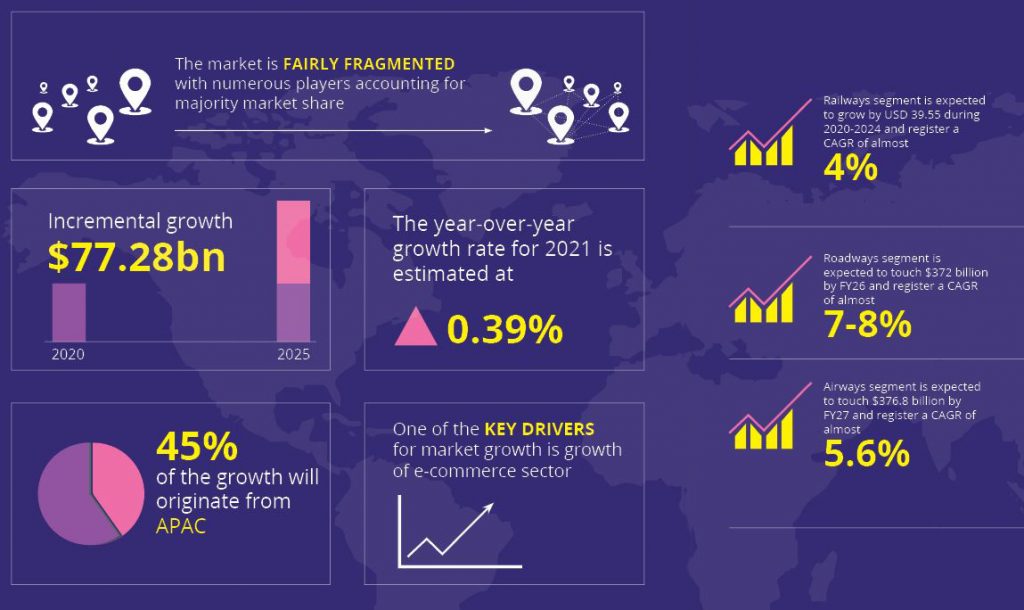In 2017, the global logistics market was valued at $7,641.20 billion. It is projected to grow by USD 77.28 billion, progressing at a CAGR of almost 2% during 2021-2025.
The outbreak of the Covid-19 pandemic led to the massive slowing of the supply chain and logistic activities. Many logistics companies got directly affected by the pandemic but there are some industries that are thriving in the market like healthcare and pharmaceuticals. Ecommerce and the daily essentials goods industry have affected the logistics industry positively during the outbreak at the global level. The demand for medical and FMCG supplies such as vaccinations, gloves, sanitizers, and other essential goods is also propelling. All these developments in different industries are leading to the growth of the logistics sector.
KEY TRENDS INFLUENCING THE LOGISTICS MARKET
1. Increase in Cross Border Trade
Cross Border trade involves the exchange of goods and services across international borders. It allows enterprises to expand their business in terms of demographics and geography. It also helps countries in boosting their economy as the sale and purchase of goods leads to an increase in tax and revenue. This eventually leads to a substantial increase in the Gross Domestic Product (GDP) of countries. The growth of cross-border trade can prove to be a significant contributor to overall economic growth which can eventually lead to the growth of the logistics market.
2. Technological Advancements
The use of Radio Frequency Identification, Bluetooth, and many other new technologies such as drone delivery and driverless vehicles is being introduced in logistics services. These fast-growing technological advancements are serving as a catalyst to the growth of the logistics market. It is predicted that the logistics industry can benefit immensely from the latest technology. The breakthroughs in technology can push the boundaries of logistics services for years to come.
3. Growth of the e-commerce sector
Due to the increased penetration of the internet globally and the increasing access to smartphones, the ecommerce sector is growing at a very fast pace. Ecommerce sector has a direct impact on the logistics market. In recent years, consumers have stopped going to physical stores to buy anything instead they prefer to shop online. Their first interaction with the brand is the package that gets delivered to their doorstep. Since the movement of these goods is highly dependent on the transportation and distribution network, the importance of logistics is growing exponentially.
Moreover, the provision of efficient last-mile delivery is also witnessing a boom in the logistics sector. Last-mile delivery services is creating yet another opportunity for the growth of the logistics market in the future.
4. Rise in Globalization
As globalization is on the rise, different trade-related activities are also increasing. Therefore, it is becoming difficult for manufacturers and distributors to keep an effective track of these activities. Here, the role of Logistics comes into play. This aspect is expected to significantly drive the logistics market size.

KEY REGIONS FOR LOGISTICS MARKET
According to Technavio, 45% of the market growth will originate from the Asia Pacific region between 2021 to 2025. In the APAC region, China and Japan would record the highest growth. The report also mentions that the presence of a large consumer base for both essential goods and healthcare products, the rise in disposable incomes, and the growing population will facilitate the growth in the logistics industry in the APAC region.
LOGISTICS MARKET KEY SEGMENTATION
The logistics market is segmented based on modes of transport like roadways, airways, and railways.
1. Rail Logistics
The rail logistics industry is expected to grow by USD 39.55 billion during 2020-2024. It will grow at a CAGR of almost 4%. Railways are now becoming a preferred mode of transportation because of low transportation charges, higher fuel efficiency, and the ability to carry a high capacity of goods. 33% of the growth will originate from the North American region. Due to the highly developed rail infrastructure and railway expansion projects, the rail logistics market will increase in the North American region.
2. Road Logistics
According to sources, road logistics is likely to grow with a CAGR of 7-8% to touch $372 billion by FY26. Of this, 86% will be driven by intercity and 14% by intracity logistics. In the Post-covid world, road logistics is witnessing an increased demand because of the increasing online adoption. 46% of the growth will originate from the Asia-Pacific region.
3. Airways Logistics
In 2019, the global air freight market was valued at $270.2 billion, but by 2027 it is projected to reach $376.8 billion at a CAGR of 5.6%. Almost 44% of the overall market growth will originate from the Asia-Pacific region. Increasing infrastructural development activities and investments in the modernization of airports in countries such as India, Australia, Singapore, and the Philippines are some of the prominent factors contributing to the air freight services market growth. According to statistics, the growth in the APAC market will be faster than in any other geography.
FINAL WORDS
The logistics market is experiencing a much-needed process standardization, technological upgradations, and digital transformation. During the outbreak of Covid-19, from managing local requests and delivering medicines at doorsteps to international transportation for various needs, the logistics industry has tirelessly fulfilled the massive demands worldwide.
SOURCE: The information in this article is noted from the Technavio and Allied Market Research reports on Global Logistics Market. Technavio is a leading global technology research and advisory company. Allied Market Research is a market research company that provides business insights and market research reports.



